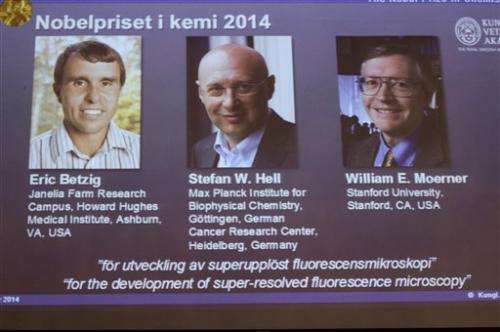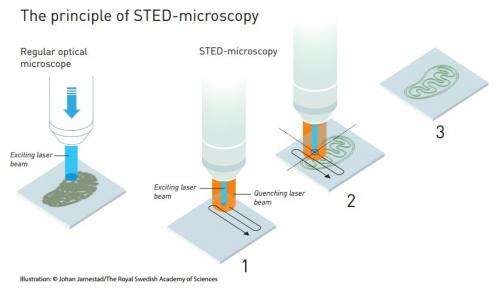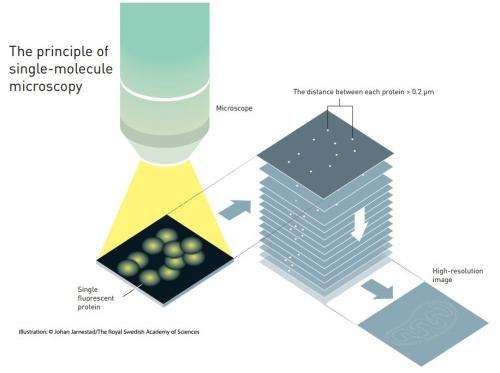Two Americans, one German win Chemistry Nobel for giving microscope sharper vision

Two Americans and a German scientist won the Nobel Prize in chemistry on Wednesday for finding ways to make microscopes more powerful than previously thought possible, allowing scientists to see how diseases develop inside the tiniest cells.
Working independently of each other, U.S. researchers Eric Betzig and William Moerner and Stefan Hell of Germany shattered previous limits on the resolution of optical microscopes by using glowing molecules to peer inside the components of life.
Their breakthroughs, starting in the 1990s, have enabled scientists to study diseases such as Parkinson's, Alzheimer's and Huntington's at a molecular level, the Royal Swedish Academy of Sciences said.
"Due to their achievements, the optical microscope can now peer into the nanoworld," the academy said, giving the 8 million-kronor ($1.1 million) award jointly to the three for "the development of super-resolved fluorescence microscopy."
Betzig, 54, works at the Howard Hughes Medical Institute in Ashburn, Virginia. Hell, 51, is director of the Max Planck Institute for Biophysical Chemistry in Goettingen, Germany, and also works at the German Cancer Research Center in Heidelberg. Moerner, 61, is a professor at Stanford University in California.
"I was totally surprised, I couldn't believe it," said Hell, who was born in Romania. "Fortunately, I remembered the voice of Nordmark and I realized it was real," he added, referring to Staffan Nordmark, the academy's permanent secretary.
The Nobel judges didn't immediately reach Moerner, who was at a conference in Brazil. The American found out about the prize from his wife after she was told by The Associated Press.
"I'm incredibly excited and happy to be included with Eric Betzig and Stefan Hell," Moerner told the AP.
Betzig said he started to tremble when he saw an incoming call from Sweden, receiving the news with a mix of happiness and fear.
"Because I don't want my life to change. I really like my life, and I'm busy enough already," he told journalists in Munich, where he was giving a lecture.
For a long time optical microscopes were limited by the wavelength of light and other factors, so scientists believed they could never yield a resolution better than 0.2 micrometers.
But the three scientists were able to break that limit by using molecules that glow on command. The advance took optical microscopy into a new dimension that made it possible to study the interplay between molecules inside cells, including the aggregation of disease-related proteins, the academy said.
The technology offers advantages over an electron microscope, which offers slightly better resolution but can't be used to examine cells that are alive.
"You really need to be able to look at living cells because life is animate—it's what defines life," Betzig said.
Hell used these methods to study nerve cells to get a better understanding of brain synapses; Moerner studied proteins related to Huntington's disease; and Betzig tracked cell division inside embryos, the academy said.
Hell said he was convinced that as a result of the discovery scientists will be able to find out more quickly what happens in a cell when a disease emerges.
"Any disease, in the end, can be boiled down to a malfunctioning of the cell," he said. "And in order to understand what a disease actually means, you have to understand the cell and you have to understand the malfunction."
Moerner said scientists can now tell whether individual molecules are different or the same.
"It's very much like asking whether they all march to the same drummer or not," Moerner told the AP. "When you can watch one by one, then we are able to observe exactly when it changes from one state to another."
The technology lets scientists see "way below" the traditional limit for resolving detail with light microscopes, said Catherine Lewis, director of the cell biology and biophysics division at the National Institute of General Medical Sciences in Bethesda, Maryland.
"You can observe the behavior of individual molecules in living cells in real time. You can see ... molecules moving around inside the cell. You can see them interacting with each other," she said.
That gives a foundation for research into controlling those interactions in a way that may treat or diagnose disease, she said.
Nobel committee member Claes Gustafsson called the laureates' work "a revolution, because as recently as 15 years ago, it was believed to be theoretically impossible to break this barrier."
This year's Nobel awards began Monday with U.S.-British scientist John O'Keefe splitting the medicine award with Norwegian couple May-Britt Moser and Edvard Moser for brain cell research that could pave the way for a better understanding of diseases like Alzheimer's.
On Tuesday, Isamu Akasaki and Hiroshi Amano of Japan and Japanese-born U.S. scientist Shuji Nakamura won physics award for the invention of blue light-emitting diodes—a breakthrough that spurred the development of LED technology that can be used to light up homes and offices and the screens of mobile phones, computers and TVs.
The Nobel Prize in literature will be announced Thursday, followed by the Nobel Peace Prize on Friday and the economics prize on Monday.
The prizes are always handed out on Dec. 10, the date that prize founder Alfred Nobel died in 1896.

The Royal Swedish Academy of Sciences Announcement
The Royal Swedish Academy of Sciences has decided to award the Nobel Prize in Chemistry for 2014 to
Eric Betzig
Janelia Farm Research Campus, Howard Hughes Medical Institute, Ashburn, VA, USA,
Stefan W. Hell
Max Planck Institute for Biophysical Chemistry, Göttingen, and German Cancer Research Center, Heidelberg, Germany
and
William E. Moerner
Stanford University, Stanford, CA, USA
"for the development of super-resolved fluorescence microscopy"

Surpassing the limitations of the light microscope
For a long time optical microscopy was held back by a presumed limitation: that it would never obtain a better resolution than half the wavelength of light. Helped by fluorescent molecules the Nobel Laureates in Chemistry 2014 ingeniously circumvented this limitation. Their ground-breaking work has brought optical microscopy into the nanodimension.
In what has become known as nanoscopy, scientists visualize the pathways of individual molecules inside living cells. They can see how molecules create synapses between nerve cells in the brain; they can track proteins involved in Parkinson's, Alzheimer's and Huntington's diseases as they aggregate; they follow individual proteins in fertilized eggs as these divide into embryos.
It was all but obvious that scientists should ever be able to study living cells in the tiniest molecular detail. In 1873, the microscopist Ernst Abbe stipulated a physical limit for the maximum resolution of traditional optical microscopy: it could never become better than 0.2 micrometres. Eric Betzig, Stefan W. Hell and William E. Moerner are awarded the Nobel Prize in Chemistry 2014 for having bypassed this limit. Due to their achievements the optical microscope can now peer into the nanoworld.
Two separate principles are rewarded. One enables the method stimulated emission depletion (STED) microscopy, developed by Stefan Hell in 2000. Two laser beams are utilized; one stimulates fluorescent molecules to glow, another cancels out all fluorescence except for that in a nanometre-sized volume. Scanning over the sample, nanometre for nanometre, yields an image with a resolution better than Abbe's stipulated limit.
Eric Betzig and William Moerner, working separately, laid the foundation for the second method, single-molecule microscopy. The method relies upon the possibility to turn the fluorescence of individual molecules on and off. Scientists image the same area multiple times, letting just a few interspersed molecules glow each time. Superimposing these images yields a dense super-image resolved at the nanolevel. In 2006 Eric Betzig utilized this method for the first time.
Today, nanoscopy is used world-wide and new knowledge of greatest benefit to mankind is produced on a daily basis.
More information: The Nobel Prize in Chemistry 2014: www.nobelprize.org/nobel_prize … stry/laureates/2014/
Scientific Background: www.nobelprize.org/nobel_prize … emistryprize2014.pdf
© 2014 The Associated Press. All rights reserved.


















